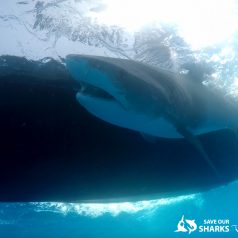
In October 2016, the Dutch Caribbean Nature Alliance (DCNA) organized a unique shark tagging expedition to the Saba Bank. Little is currently known about the status of shark populations in Dutch Caribbean waters and shark tagging studies are a pivotal first step in determining which sharks are present, where they can be found, and most importantly to provide an insight into their range state and migration patterns. This information will be used to determine how best to manage and protect these important apex predators.
During the shark tagging expedition, scientists and conservationists from the Saba Conservation Foundation (SCF), Nature Foundation St. Maarten (NFSXM), Florida International University (FIU), and Sharks4Kids used the research vessel “Caribbean Explorer II” to assess the abundance and diversity of sharks on the Saba Bank.
Drum lines were used to catch a total of 22 sharks during the course of the six-day expedition. The sharks that were tagged included 16 Caribbean reef sharks (Carcharhinus perezii) and six adult tiger sharks (Galeocerdo cuvier).
The Caribbean reef sharks were each fitted with PIT tags. These tags were inserted under the skin just below the first dorsal fin. PIT stands for Passive Integrated Transponder, which acts essentially as a lifetime barcode for a specific animal, allowing scientists to identify individual animals and to record where they are spotted.
The team also caught six adult tiger sharks, which are known to be highly migratory (Papastamatiou et al., 2013) and to overwinter in the Caribbean. Along with PIT tags, four of these sharks were equipped with Wildlife Computers SPOT (Smart Position or Temperature Transmitting) tags, which were attached to the first dorsal fin. These tags transmit to satellites, which allow the sharks to be tracked through the ARGOS system for up to four years. The tags use radio transmissions, so the satellite unit must be exposed to air in order to transmit. Each time the dorsal fin breaks the surface a geolocation provides an approximate location with an accuracy of a few hundred meters.
In contrast to most other species of shark, tiger sharks spend some time at the surface (Werry et al., 2014) making them ideal subjects for satellite tagging studies. Both Caribbean Reef sharks and tiger sharks are listed as “Near Threatened” on the IUCN red list of Threatened species (Friendlander and DeMartini, 2002; Simpfendorfer, 2009). Tiger sharks, in particular, provide important trophic links between distant habitats throughout the Caribbean since they are known to migrate up to 6747 km across ocean basins (Kohler et al., 1998). Tiger shark dispersal patterns are complex and can be considered a mix of inter-island movements, potentially linked to foraging, and long-distance migration, which may be triggered by their reproductive cycle, since their reproductive cycle is believed to be triennial and 3-yearly migration patterns have been observed in adult female tiger sharks (Papastamatiou et al., 2013).
Despite the precipitous decline of shark populations worldwide due to chronic overfishing and slow reproductive life-history characteristics (Myers et al., 2007), a relatively high number of sharks can be found on the Saba Bank (Stoffers, 2014). Using BRUV (Baited Remote Underwater Video) studies in the Bahamas (Brooks et al., 2011) and Belize (Bond et al., 2012) for comparison, shark numbers on the bank seem relatively high. Sharks are found close to the shallow edges of the bank in the South and East, where the ocean floor continues in a steep drop-off. The relatively high shark abundances on the Saba bank could be explained by the lack of destructive industrial fishery methods, such as longlining, gillnetting and directed fisheries for shark fins. This is a good sign for the health of the Saba Bank ecosystem, since sharks are apex predators, making them a prime indicator of ecosystem health.
Preliminary results from the shark tagging expedition are allowing a juvenile female tiger shark to be tracked in the near shore waters around St Maarten ranging from the French to the Dutch side of the islands and back again. Strikingly, the shark is most active at the surface at dawn and dusk. Of the four tracking devices placed on adult female tiger sharks, two are transmitting but the sharks have not surfaced long enough for them to be positively located, one has yet to transmit data and one large female tiger shark has been providing excellent data and has traveled as far as the waters of Guyana.
This shark tagging expedition was funded by the Dutch Postcode Lottery as part of a region-wide “Save Our Sharks” project. The aim of the three-year-long project is to generate substantial public support for shark conservation, to ban commercial and targeted fishing for sharks in Dutch Caribbean water and ultimately establish shark sanctuaries as a safe haven for sharks.
Picture by Jillian Morris
References
Bond, M. E., E. A. Babcock, E. K. Pikitch, D. L. Abercrombie, N. F. Lamb, and D. D. Chapman. (2012). Reef sharks
exhibit site-fidelity and higher relative abundance in marine reserves on the Mesoamerican Barrier Reef. PloS one 7:e32983.
Brooks, E. J., K. A. Sloman, D. W. Sims, and A. J. Danylchuk. (2011). Validating the use of baited remote underwater video surveys for assessing the diversity, distribution, and abundance of sharks in the Bahamas. Endang Species Res 13:231-243.
Friedlander AM, DeMartini EE (2002) Contrasts in density, size and biomass of reef fishes between the northwestern and the main Hawaiian Islands: the effects of fishing down apex predators. Mar Ecol Prog Ser 230: 253–264.
Kohler NE, Casey JG, Turner PA (1998) NMFS cooperative shark tagging program, 1962–93: an atlas of shark tag and recapture data. Mar Fish Rev 60 (2): 87.
Myers RA, Baum JK, Shepherd TD, Powers SP, Peterson CH (2007) Cascading effects of the loss of apex predatory sharks from a coastal ocean. Sci 315: 1846–1850.
By Twan Stoffers





